








Five years ago, a little-used community center on Bon View Ave in Ontario sat adjacent to four acres of empty, weed-ridden land. Without the funds to offer physical activities or other programming to serve local residents, the ‘community’ part of the center remained elusive. Today, though, that same Dorothy A. Quesada (DAQ) Community Center is a hub for dance, fitness and nutrition classes. And that once neglected lot next-door is now the site of Huerta del Valle, a lush community garden that has sparked an economic and social movement that’s making waves throughout the entire city.
So what happened in Ontario? In 2012, the city became part of Kaiser Permanente’s Healthy Eating Active Living (HEAL) Zone Initiative, an ambitious funding effort designed to engage residents in collaboration with civic and community leaders to make their communities healthier and more active. Community Partners has served as the organizational intermediary to Kaiser Permanente, helping to guide the development of each of the 10 ‘zones’ across Southern California through ongoing leadership development, providing technical assistance and helping to build residents’ capacity to sustain the effort for the long term.
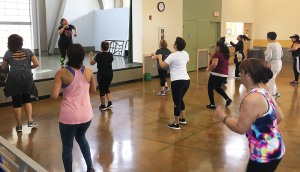 “It’s creating safety in our parks, it’s creating community connectedness, it’s creating health and wellness, mental health is improving, physical health is improving, it’s wonderful,” says Karen Thompson, associate planner for the City of Ontario. “Friendships are being formed because people are connecting.” The DAQ Community Center is one of nine community centers in Ontario that now provide free, one-hour Zumba classes three times a day, six days a week. Seven Ontario residents received Zumba training and certification through HEAL and are now employed as instructors. “We literally wanted people to be able to roll out of bed and be able to walk to a Zumba class or an exercise class.
“It’s creating safety in our parks, it’s creating community connectedness, it’s creating health and wellness, mental health is improving, physical health is improving, it’s wonderful,” says Karen Thompson, associate planner for the City of Ontario. “Friendships are being formed because people are connecting.” The DAQ Community Center is one of nine community centers in Ontario that now provide free, one-hour Zumba classes three times a day, six days a week. Seven Ontario residents received Zumba training and certification through HEAL and are now employed as instructors. “We literally wanted people to be able to roll out of bed and be able to walk to a Zumba class or an exercise class.
Secondly, we wanted community members to get involved in HEAL and use Zum Up! to use leadership development as a foundation to teach the instructors how to be a health champion and influence their community,” said city partner Evette De Luca, executive director of Partners for Better Health. In addition to creating the seven exercise instructor positions for residents, the HEAL initiative also employs 10 promotoras, Latino residents who are trained in health education and who augment Zumba classes by providing nutrition information and workshops, which also serves as another way to keep residents engaged with new policies and developments within the city.
Community Partners staff members Judy Harper and Arpiné Shakhbandaryan work with the 10 HEAL Zone sites and partner organizations to connect them with resources and champion their ideas to create healthier and happier communities. “Judy’s energy is amazing and Arpiné is so wonderful. She used to work for a city in El Monte, so she understands the framework that I work in. Judy has her community advocacy hat, I have my city hat, Evette has her community organizing hat and Arpiné can wear both hats! We’re creating a movement, and you come out here and you can see it,” said Thompson.
 Another integral piece of that movement is Ontario’s first community garden, Huerta del Valle. Ontario resident Maria Alonso, facing the realities of living in a ‘food desert,’ became a passionate advocate for community gardens and eventually caught the attention of City officials. “I had to drive ten miles to buy organic food and it was expensive!” she said recently. “I was sad that I could not feed my family good food.” The City of Ontario provided the land, fencing and water for the space that would become Huerta del Valle, and Alonso spearheaded its development.
Another integral piece of that movement is Ontario’s first community garden, Huerta del Valle. Ontario resident Maria Alonso, facing the realities of living in a ‘food desert,’ became a passionate advocate for community gardens and eventually caught the attention of City officials. “I had to drive ten miles to buy organic food and it was expensive!” she said recently. “I was sad that I could not feed my family good food.” The City of Ontario provided the land, fencing and water for the space that would become Huerta del Valle, and Alonso spearheaded its development.
The investment sparked new economic and food access opportunities not only within the Zone’s 1.3 square miles, but throughout the city. Today, the garden offers free nutrition and cooking classes, sells fresh produce at local farmers markets, and maintains several contracts with local restaurants which both supports those local businesses and expands healthy food access in a region where one in three residents is considered to be overweight or obese. Each week Ontario residents visit the garden and walk away with anything from blooms of crisp kale, plump heirloom tomatoes, freshly cut cactus (a staple in Latino homes) and, if they’re lucky, a pack of soft corn tortillas: ground, rolled and patted warm right after Maria’s cooking class. The organic produce is available to the community for $1 a pound, or for free in exchange for volunteer hours at the garden.
“The HEAL Zone has laid the foundation for all of the work that we’re doing,” adds Thompson. “I think it’s why Ontario has been successful and competitive in receiving additional grant funding and investments from outside funders.” But funders are not the only ones who’ve taken notice of Ontario’s successful strategies; Congresswoman Norma Torres visited the garden recently because she wants to adopt the same model in her hometown of nearby Pomona.
Ontario’s success is just one of many examples of how Kaiser Permanente’s HEAL Zones Initiative is empowering residents around Southern California to make healthy choices easier, more abundant and more accessible in their communities.



Fresh out of the 2016 presidential elections, policy veteran Heather McCulloch gathered a small but energized group of funders, policy advocates and organizers at the Aspen Institute to discuss an issue that was on all of their minds: the women’s wealth gap and what to do about it.
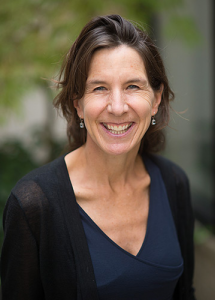 While the income gap between men and women is no secret in this country, the resulting wealth gap is much less understood or discussed but far more detrimental to the economy and the success of communities. The women’s wealth gap in the US is so large, in fact, that even if we remedied the pay gap, the wealth gap would remain. Currently the average woman owns just 32 cents for every one dollar owned by men; for women of color it’s merely pennies.
While the income gap between men and women is no secret in this country, the resulting wealth gap is much less understood or discussed but far more detrimental to the economy and the success of communities. The women’s wealth gap in the US is so large, in fact, that even if we remedied the pay gap, the wealth gap would remain. Currently the average woman owns just 32 cents for every one dollar owned by men; for women of color it’s merely pennies.
“I wasn’t sure if anything was going to come out of that first meeting,” said McCulloch. “But to my surprise, word spread and folks started contacting me offering anything they could to work on this issue.”
Three years later, that momentum has coalesced as Closing the Women’s Wealth Gap, a network of over 400 members that now includes financial institutions and public and private companies. McCulloch shared, “We grew so fast and keep growing, making the move to Community Partners essential.”
Closing the Women’s Wealth Gap has mapped out a whole array of strategies to help improve the barriers that prevent low-income women from accumulating wealth. “What it comes down to is access. Access to financial advice at key points in their lives, access to affordable child care, access to credit, access to supportive services, protection from falling prey to sub-prime lenders and predatory public and private sector practices,” McCulloch explained.
This past year, Closing the Women’s Wealth Gap activated their members with compelling research and information and amplified the strides made by their members through op-eds and social media advocacy. Two initiatives the network supported are now moving forward in California to help working families. The CalEITC is a state Earned Income Tax Credit to benefit working families (women are more likely to be the primary or sole earner in most households than ever before). And the Cal Savers program, which launched as a pilot in November 2018 and will open up to all employers this July 1, will provide all California employees with access to retirement savings accounts if their employer does not currently offer it (women and people of color are more likely to be left out of current employer-provided retirement savings plans).
Up next, Closing the Women’s Wealth Gap has its eye on supporting the initiative for paid leave and baby bonds, which would offer low-income women financial security in times of need and more affordable opportunities for investments. McCulloch also plans to capitalize on the increasing number of women in public office. “We plan on inserting these initiatives into the primary election conversations,” she said. “We’ll be holding a national convening to coincide with the 2020 presidential election, and it will give us a chance to see how our work has culminated thus far.”
Image: Closing the Women’s Wealth Gap Executive Director Heather McCulloch


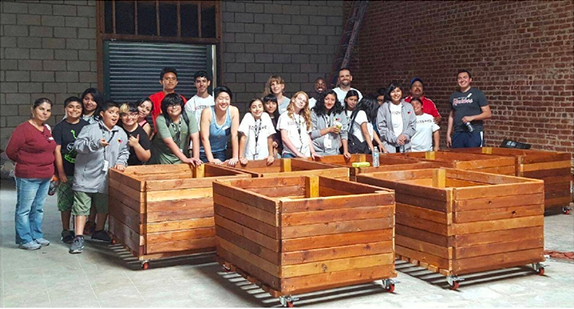
What does it mean to be an engaged citizen in 2017? That’s the vision behind Changeist, a project that encourages youth ages 11-26 to move beyond traditional ideas about citizenship and community service. Bringing young people together from different backgrounds, cultures, and zip codes is something executive director Mario Fedelin feels strongly about.
“We’re trying to bring people together to do better for our neighbors. It’s not about trying to save black kids or brown kids. Society needs to stray away from that mentality of having to be served if you’re poor or having to volunteer if you have means so that you can feel really good about yourself. Big Citizen Hub joins young people with means and those without to perform service activities because that will change the world.”
The program partners with Los Angeles schools by engaging with counselors and teachers to develop an outreach plan. Fedelin visits homerooms, clubs and students who have been nominated by their teachers to participate. His pitch: “This is not an intervention. Kids that join this program are not bad kids, we’re not trying to fix you. We’re looking for people who want to change certain things that they see. If you think that you can change the world, this may be the place for you.” And the response has been excellent.This year 170 middle and high school students from 43 different zip codes in Los Angeles spent 22 Saturdays performing service activities on behalf of causes that moved them. This kind of response has been evident since Changeist’s beginnings in 2014; it only took one month of recruiting to enroll their first class of 75 students. “The one concept that I can always count on is that kids’ today have a profound desire to do something that can make a difference,” says Fedelin.
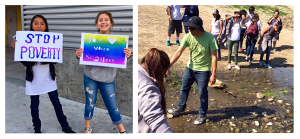 Once Big Citizens apply and are assigned to their teams in the program, they decide which issues in their communities they’d like to tackle and lean on Fedelin and staff for logistical support. Some highlights of this past year’s projects include a youth-organized Anti-Bullying festival in Boyle Heights that used role-playing and skits to demonstrate tactics to counter bullying; a project that resulted in fifteen home-made blankets and 150 snack bags delivered to homeless youth in Hollywood; the removal of invasive plants in Mono Lake basin; and a neighborhood cleanup in Huntington Park.
Once Big Citizens apply and are assigned to their teams in the program, they decide which issues in their communities they’d like to tackle and lean on Fedelin and staff for logistical support. Some highlights of this past year’s projects include a youth-organized Anti-Bullying festival in Boyle Heights that used role-playing and skits to demonstrate tactics to counter bullying; a project that resulted in fifteen home-made blankets and 150 snack bags delivered to homeless youth in Hollywood; the removal of invasive plants in Mono Lake basin; and a neighborhood cleanup in Huntington Park.
The inspiration for Changeist came to Fedelin as a 20-year-old, walking around downtown San Jose, contemplating whether he really wanted to go back to school. Fedelin stumbled upon a group of young people performing service work in an alleyway. He approached them and found out that they were part of a group called City Year, an organization Fedelin had volunteered with in high school—and they were hiring. “Within a couple weeks I was thrust into this diverse team and began working on projects in my neighborhood and different cities with these kids that were very different than me. Most were college educated and I had this really amazing year of learning not only technical skills, but also learning about my own biases. That type of immersion changed my life. I signed up for only 11 months and ended up staying 11 years.”
His passion for empowering youth to work together to make change eventually led him to Community Partners in 2014, where his social entrepreneurial risk-taking was met with logical guidance. “To this day my program liaison Ravi Shah still reminds me to spend funds thoughtfully and conservatively. He changed my whole approach for the better. At Community Partners there is such trust and sincere guidance; I’ve found some of the best people here.”
While not typically surprised by the compassion and dedication of his Changeist participants, Fedelin was caught off-guard by one recent project. Twenty-five of the project’s kids came forward with a desire to help Changeist as it vied for a coveted $100,000 LA2050 grant challenge through the Goldhirsh Foundation, an annual grants competition that depends on public voting. “They thought that Changeist was so important that they all ran individual campaigns in their own neighborhoods and schools,” said Fedelin of their efforts that perfectly exemplified the mission of Changeist: taking action for something you believe makes the world a better place. “They gave presentations explaining why we need Changeist,” said Fedelin. “They won this grant for us, hands down.”



At first look, one might not think the two bereavement groups that met separately at Dolores Mission in East LA had anything in common. One group was made up of the family members of murdered individuals – sons, daughters, nieces, nephews. The other, the families of mostly young men incarcerated, often for life, for violent crimes.
They attended mass each week separately as well, explains Javier Stauring, who oversaw both support groups as part of his work with the Archdiocese of Los Angeles. Then a mother who was dealing with the murder of her son, suggested the two groups join together for that weekly mass. The group members agreed, and as they began attending services together they also opened the door to a new kind of approach to healing.
It was the beginning of a new idea for Stauring, who left the Diocese in 2015 and started his own program, Healing Dialogue and Action. Now these two seemingly dissimilar groups come together regularly, supporting one another through unimaginable pain and grief. “The suffering is very similar between these two groups,” Stauring notes. “They all have misconceptions of who the other side is, what they’re thinking, what they’re going through.”
To illustrate, he remembers the mother of a young man who’d committed murder and went to prison. “She didn’t feel like she deserved to cry” when faced with mothers whose sons had been killed, he explains. But one of the other mothers embraced her, telling her she had every right to her own painful feelings. “These families experience so much shame, and to be able to be accepted and by someone who represents where her shame comes from…is profound and powerful.” The mutual support and understanding that develops through the process, Stauring believes, can help people in their healing process and break the cycle of retribution and violence.
As the program continues to grow, Stauring credits fiscal sponsorship with offering more freedom to focus on the work at hand.
“Oh my god,” he says, “coming to Community Partners enabled us to do what we’re good at…and not worry about so many administrative responsibilities.”
In addition to bringing people together through the facilitated support groups, Healing Dialogue and Action also advocates and works toward systemic change. They worked for seven years to pass SB 9, which gives a second chance to people who were under the age of 18 at the time of their crime and sentenced to life without parole. Symposiums held inside prisons offer a chance for legislators, district attorneys, and prison administrators to hear stories from families of both victims and perpetrators, and to then discuss a specific reform issue.
With eight families of young men killed at the hands of police currently working together in a group in East LA, Stauring is also helping them advocate for the release of police records that until a recent law was passed, were never made public. “Families just want to know what happened…even if they understand that their child was most likely culpable; having no idea about what took place prevents them from healing, from moving on.”
It’s difficult, painful work, but Stauring is deeply passionate about it. “It is a privilege to witness and walk beside these people,” he says.
Keep an eye out over the next month for a CNN-produced series with Don Lemon about restorative justice that will include Javier Stauring and the work of Healing Dialogue and Justice.
Pictured above: Juana and Bertha, two mothers connected by homicide, have found healing together


“It’s the little things…”
Transitional housing accommodations, very welcome first residences for people moving out of homelessness, can be stark, institutional places. But an all-volunteer group is working quietly and effectively to change that.
Take, for example, the story of a 60-year-old single father of two. He arrived at his first new apartment after a long day of bus rides during which he juggled two young kids and their modest belongings. He said walking into a fully furnished apartment made cozy and home-like was overwhelming. Finding the refrigerator neatly stocked with a week’s worth of groceries brought him to tears. He could breathe, he said, for the first time in a long while, his family taken care of for the moment.
 The work of Topanga Women’s Circle demonstrates how much it’s the little things that can make such a big difference. “I like to think that we empower the people we help by giving them a sense of pride in their home,” said co-chair Linda Ilsley. The group regularly collects donations of bedding, furniture, clothing, toys, groceries and toiletries and then sets up house for families transitioning out of homelessness. Working with partners at Venice Community Housing and Westwood Transitional Village, the volunteers have three days to transform an empty apartment. They purchase food and stock fridges and cupboards, move in furniture and bedding from their weekly donation bin, purchase age appropriate books and toys, and set out new pajamas for the whole family. Everything is arranged by day three, including color-coordinated rooms, a washable satin robe for each mother, and other thoughtful little touches of home easily taken for granted, but meaningful when life has been lived on the street or in shelters. When it’s time for the occupants to transition to permanent housing, they get to take all of their new belongings with them to fill their new, permanent home.
The work of Topanga Women’s Circle demonstrates how much it’s the little things that can make such a big difference. “I like to think that we empower the people we help by giving them a sense of pride in their home,” said co-chair Linda Ilsley. The group regularly collects donations of bedding, furniture, clothing, toys, groceries and toiletries and then sets up house for families transitioning out of homelessness. Working with partners at Venice Community Housing and Westwood Transitional Village, the volunteers have three days to transform an empty apartment. They purchase food and stock fridges and cupboards, move in furniture and bedding from their weekly donation bin, purchase age appropriate books and toys, and set out new pajamas for the whole family. Everything is arranged by day three, including color-coordinated rooms, a washable satin robe for each mother, and other thoughtful little touches of home easily taken for granted, but meaningful when life has been lived on the street or in shelters. When it’s time for the occupants to transition to permanent housing, they get to take all of their new belongings with them to fill their new, permanent home.
TWC started at Community Partners in 2008. They helped about 40 homeless families last year—eight times the number from when they first began. Being under fiscal sponsorship has served them well. “As a young and growing charity, our knowledge of how to grow and how to build an advisory board, how to fundraise, etc. was limited. But with Community Partners – the advice, the seminars — we’ve learned so much.”
 The project continues to run as an all-volunteer effort, and it’s a model about which Ilsley has some advice: “Make sure every single volunteer understands that she, or he, is a critical and key component in the success of the charity. I wish I had known in the beginning that everyone’s contribution should be acknowledged.”
The project continues to run as an all-volunteer effort, and it’s a model about which Ilsley has some advice: “Make sure every single volunteer understands that she, or he, is a critical and key component in the success of the charity. I wish I had known in the beginning that everyone’s contribution should be acknowledged.”
For such a hands-on group – volunteers gather in sewing circles to make stuffed animals and craft Mother’s Day cards for fundraising efforts – they take a very hands-off approach when it comes to those they serve. With an understanding of the trauma that comes with homelessness, they prefer to maintain a low profile, offering dignity and comfort through the welcoming environments families can claim as their own. They don’t seek out gratitude.
“It can be hard for families, especially when a father is part of the family, not to feel a little embarrassed at our generosity. We just don’t like putting people in that position. We try to be silent donors and get in there before the family arrives so that when they move in, they feel like they’ve stepped into a wonderful fairy tale where life is suddenly a little sweeter.”



What do you get when you bring together some of the world’s most innovative engineers, creators and problem solvers with a mission to make the world a better place? You get Cleantech Open’s annual “Global Forum,” an inspiring, sometimes mind-boggling competition that serves as the culmination of the organization’s mentorship and accelerator program. This year’s event is set for Jan. 29 at the La Kretz Innovation Campus in DTLA.
Cleantech Open has been finding, fostering and funding tech entrepreneurs with out-of-the-box ideas to solve the planet’s greatest environmental and energy challenges since its inception in 2005.
“Our entrepreneurs are very engineering and tech savvy but are not necessarily business savvy and our goal is to help them be successful,” said Executive Director Ken Hayes. By teaching these talented engineers how to operate a business, Cleantech Open aims to level the playing field in the sector. Through the accelerator program, entrepreneurs learn how to create a business model, identify competitors, build a team, and understand the need for partnerships. They are also matched with mentors that fit their particular needs. Once participants have completed the program, they have the opportunity to compete in regional “shark tank” style competitions within their local Cleantech Open chapters, found in six regions around the country, with finalists moving on to the Global Forum. International applicants also can apply through the “Global Ideas” program. Expanding their reach geographically is one way Cleantech Open works to dispel the notion that successful and innovative startups can only be found in Silicon Valley.
More than 100 startups championing cleantech— defined as environmental and sustainable technologies—will be showcasing their inventions on the “convention” floor in the areas of energy use, agriculture, water, transportation and smart cities. Eleven finalists will pitch their ideas to attendees and compete for the grand prize.
Last year’s Global Forum winner, Inovues, was awarded $50K to use toward an innovative way to upgrade windows in commercial buildings that significantly improves insulation and energy efficiency. If only 20 percent of single-pane buildings implemented their invention, the environmental impact would be the equivalent of taking two million cars off the road each year. Inovues also received exposure to private and government investors in addition to the prize money.
Cleantech Open became a fiscally sponsored project of Community Partners in 2018 and given our shared passion for the entrepreneurial spirit and mission-driven projects, the relationship is particularly synergistic.
“An added benefit of joining Community Partners is the opportunity to connect with the other 181 projects and the communities they serve,” Hayes noted. “So many of the worst impacts of poor environmental policies or technologies affect underserved communities. I’m hoping we’ll get to know those programs so that we can work together to improve the quality of life in all neighborhoods.”
To learn more about Cleantech Open and their upcoming Global Forum, click here for tickets. If you are a project of Community Partners and are interested in attending, contact your program liaison.
Interested in learning more about Cleantech Open’s entrepreneurs and their tech? Follow #CTOAlumniSuccess on Twitter to view past cohorts and where they are now.



On a rainy afternoon in 2010, a man is running, completely soaked in his orange CalTrans suit as he ducks into the Libros Schmibros lending library in Boyle Heights. He calls out, “I only have a minute. Do you have some Trotsky?” “In English or Spanish?” replies co-founder Colleen Jaurretche.
Located in the iconic Mariachi Plaza in historic Boyle Heights, where since the 1930s mariachis have gathered to serenade the city in hopes of being hired by passersby, Libros Schmibros serves a new generation of passersby of all ages. Many are bilingual or non-English speaking. They come with their children, or stop in on their way to or from work to find an array of literary treasures. They even duck in out of the rain, taking a chance without much time to spare and are rewarded with a Spanish translation of a Russian revolutionary.
“The Boyle Heights community is our first and foremost concern,” says co-founder David Kipen. “Putting books into people’s hands four days a week with hopes for more.” When Kipen an author, UCLA professor and frequent book reviewer for the Wall Street Journal, L.A. Times, New York Times, and on KPCC, relocated to Boyle Heights in 2010, he learned that local libraries city-wide were going to start closing on Mondays, leaving residents who were already in a literary desert with even less access to books. He and Colleen Jaurretche, a fellow UCLA professor, reviewer and essayist, joined forces and launched the library shortly after. Book lovers don’t necessarily need to live in Boyle Heights to enjoy the lending library; you can visit Thursdays – Sundays and checkout up to three books at a time after purchasing a $5 membership. But the library’s accessibility doesn’t stop there.
Last year, in an effort to create a flexible program that would be a playful, creative way to get books into people’s hands, a generous gift from The Metabolic Studio allowed Libros to pilot their Bicycle Libraries. Custom bicycles outfitted with book carriers on each side serve as a library on the move. The Bicycle Libraries have inspired many students from local high schools to volunteer and ride the bikes all over the city. “The heart of the program is that they instigate conversation about literature with the general public. To their delight, people are overwhelmingly happy and grateful to receive a book, and when the kids come back, they share with us all of those wonderful conversations,” said Jaurretche. Next year, USC is looking to partner with Libros to develop a bicycle library model for its campus.
Despite the rich cultural and language diversity within Boyle Heights, not one public library in the area offers bilingual story hours for children. In the coming months, Libros will be launching a series of podcasts for bilingual children in an effort to expand the reach of their Children’s Reading Hour, which currently take place the last Sunday of every month and are led by bilingual librarians. In addition, Libros plans to put writers into classrooms for ten weeks to encourage kids to explore writing for fun and creativity, rather than as a chore.
Kipen’s and Jaurretche’s driving force has been their shared passion for books and for literary accessibility for people of all ages and cultures, no matter where they reside in the city. But they also stay focused on their mission thanks to supporters. “It’s the encouragement not just of the newspapers and generous funders, it was the encouragement of Community Partners. Community Partners has been right there for us in a number of ways,” said Kipen.
Jaurretche agreed: “The encouragement and mentoring from Cynthia Freeman, from Paul, and from everybody helping us with the business, administration, and the management side as a project has made these last six years possible… because there was no way we were going to be able to continue to grow the idea of Libros without that kind of support. It’s been an honor to be alongside so many other remarkable projects and it makes us feel really good!” Kipen adds, “It emboldens us to keep going, to keep putting books into people’s hands, because not only do you not know where any book you pick-up at Libros has been, you don’t know where it’s going.”



Didn’t make it to Community Partners’ annual holiday gathering last week? Well, we missed you and hope you make it next year. We celebrated with close to 200 of our closest friends, project leaders, staff, board members, funder colleagues and more.
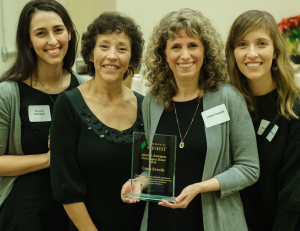 We bid farewell to three board members whose terms came to an end at the close of this year: Steve Meier, Steve Nissen, and Joy Picus served an impressive 15 years each on the Community Partners Board, and contributed greatly to our growth. A surprise recognition was offered to outgoing Community Partners Vice President Linda Fowells, after 22 years of service to the organization by CEO and founder Paul Vandeventer. And we paid tribute, as we do each year, to our co-founder Al Rodriguez, through the presentation of the Albert. R. Rodriguez Civic Legacy Honors. These accolades serve to recognize the people, partners, and important allies whose spirited dedication to ethical integrity, public accountability, and fiscal prudence reflect Al’s own core values.
We bid farewell to three board members whose terms came to an end at the close of this year: Steve Meier, Steve Nissen, and Joy Picus served an impressive 15 years each on the Community Partners Board, and contributed greatly to our growth. A surprise recognition was offered to outgoing Community Partners Vice President Linda Fowells, after 22 years of service to the organization by CEO and founder Paul Vandeventer. And we paid tribute, as we do each year, to our co-founder Al Rodriguez, through the presentation of the Albert. R. Rodriguez Civic Legacy Honors. These accolades serve to recognize the people, partners, and important allies whose spirited dedication to ethical integrity, public accountability, and fiscal prudence reflect Al’s own core values.
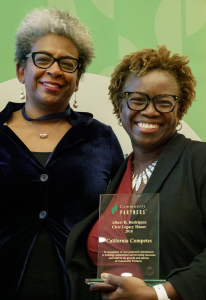 Lande Ajose, project leader, California Competes
Lande Ajose, project leader, California CompetesCalifornia Competes is working toward a more equitable system of higher education for all Californians, now under the guiding hand of Dr. Ajose, an expert in urban labor markets and higher education policy who currently serves as chair of the California Student Aid Commission. “Being here at Community Partners is what allows us to focus on our work, going around the state and talking to students, talking to administrators” and others, Dr. Ajose told the crowd.
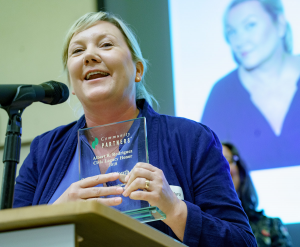 Alison Hurst, project leader, Safe Place for Youth (SPY)
Alison Hurst, project leader, Safe Place for Youth (SPY)“I started this work because I was shocked and appalled to see young people living and dying on our streets,” said Alison Hurst. That was in 2011, when she started taking care packages with friends around to homeless youth in Venice. Today SPY has a budget of almost $3M, a new building for their drop-in center, a staff of 38, and a volunteer force of 454.
 Kaiser Permanente Community Benefits
Kaiser Permanente Community Benefits We’ve been a proud partner to Kaiser’s work over the past decade, including our role on their Healthy Eating Active Living (HEAL) Initiative, the Thriving Schools Initiative, which has directed more than $1.3 million in funding to schools both regionally and nationally over the past 5 years, the formation of IHQC, now a thriving fiscally sponsored project with Community Partners, and a state-wide effort called the California Accountable Communities for Health Collaborative. Kaiser Community Benefits Manager Roberta Tinajera-Frankel, accepting the honor for Kaiser, praised the support and guidance of Community Partners staff, and said Community Partners “has taught us what true resident and youth involvement is all about.”


“Our analysis is the victims’ voices, in numerical form.”
They are data scientists and statisticians and they have gained international recognition in the human rights community for shedding the light of truth on mass killings in places like Syria, Guatemala and Chile. One of the most unique projects we sponsor, the Human Rights Data Analysis Group has assisted in successful prosecutions in international courts and in deportation proceedings against some of the world’s most notorious war criminals.
Dubbed the ‘forensic humanitarian’ by the New York Times, founder Patrick Ball’s testimony was specifically mentioned in a full court judgement released this week in the case of Chadian President Hissène Habré. The project is currently headed up by Megan Price, who spoke with our summer intern Sarah Greilsamer about new directions for HRDAG, and more.
Right now our primary substantive projects involve work in Syria, Guatemala and, for the first time, the US. In Syria, we are analyzing multiple lists of named victims who have been killed in the ongoing conflict, using information about what is known and documented to estimate what is currently unknown and missing from those data sources. In Guatemala we recently completed a short book describing the past ten years of research that we’ve conducted at the Historic Archive of the National Police and how that information ultimately contributed to expert legal testimony in two court cases in Guatemala.
Here in the US, we’ve recently begun a project to provide new tools for analysis of US policing. Last year, police killed at least 346 Black Americans. These deaths are part of a centuries-old injustice: people of color face vastly higher risk of death at the hands of police than white people. But we still don’t know enough to stop the killing.
 We need better data on police-civilian interaction, and at HRDAG we are working to improve on existing research in three important ways. The Policing Project will collect detailed, representative data on all types of police encounters, with all types of people, in all types of neighborhoods. With this “360 degree” global view, we can look more carefully at the origins of racial disparities in policing, with an eye to solutions. The second way we’re improving on research is by counting the uncounted. HRDAG researchers pioneered the use of multiple systems estimation, a statistical technique that rigorously estimates the “dark number” of unreported killings by employing multiple data sources. Nationwide, we estimate that at least 28 percent of deaths in police custody, and perhaps as many as half, go unreported. This is why it’s vital to collect multiple data sources. No other research team does this. Finally, we are involving community partners. We can create tools and train citizen scientists in Oakland (our first survey starts there) and elsewhere to collect and analyze their data. When communities are empowered to create and control their own data, they have leverage to push for increased police accountability. HRDAG has a strong track record of partnering with activists around the world.
We need better data on police-civilian interaction, and at HRDAG we are working to improve on existing research in three important ways. The Policing Project will collect detailed, representative data on all types of police encounters, with all types of people, in all types of neighborhoods. With this “360 degree” global view, we can look more carefully at the origins of racial disparities in policing, with an eye to solutions. The second way we’re improving on research is by counting the uncounted. HRDAG researchers pioneered the use of multiple systems estimation, a statistical technique that rigorously estimates the “dark number” of unreported killings by employing multiple data sources. Nationwide, we estimate that at least 28 percent of deaths in police custody, and perhaps as many as half, go unreported. This is why it’s vital to collect multiple data sources. No other research team does this. Finally, we are involving community partners. We can create tools and train citizen scientists in Oakland (our first survey starts there) and elsewhere to collect and analyze their data. When communities are empowered to create and control their own data, they have leverage to push for increased police accountability. HRDAG has a strong track record of partnering with activists around the world.
We start by relying on our partners, many of whom conduct their own data verification before sharing their records with us. We also look at basic descriptive statistics to get a sense of the data and to identify any records that stand out. This doesn’t necessarily point to “bad” data, just data that warrants further investigation to understand.
Our biggest challenges are identifying partners who can share data with us, and processing data to prepare it for analysis. For historical projects, it’s not uncommon for data to comprise physical documents or images stored as PDFs or saved on 8″ floppy discs! This requires what we refer to as “data archeology.”
The biggest change is that after years and years of focusing on human rights issues in other countries, we have begun our first US project.
When we spun out of Benetech (another tech nonprofit) we knew we weren’t prepared to handle many of the behind-the-scenes operations of our own nonprofit. We knew we needed outside help to handle payroll, insurance, benefits, audits, etc. We started researching fiscal sponsors, and Community Partners looked like (and has been) a great fit! Our relationship with Community Partners has benefited us tremendously by freeing up myself and Patrick, our director of research, to focus much more on the programmatic side of our work and less on operations. Since Suzanne (our part-time administrative manager) joined the team, Community Partners has also influenced us by helping her to better understand bookkeeping and by being patient and available to answer all of her questions. Suzanne wants to give a huge thanks and shout-out to Rick Gutierrez in Finance for all of his help with this.
Some of our most important milestones involve testifying in court cases against those charged with genocide and other crimes against humanity. Our team has prepared testimony for six different court cases, most frequently presented in court by Patrick Ball. Both General José Efraín Ríos Montt, the de-facto president of Guatemala in 1982-83, and Chadian President Hissène Habré were convicted of crimes against humanity. These convictions are extremely important for victims and their families, and represent some of the most memorable moments we have as an organization, that we contributed in some way to help bring justice.

